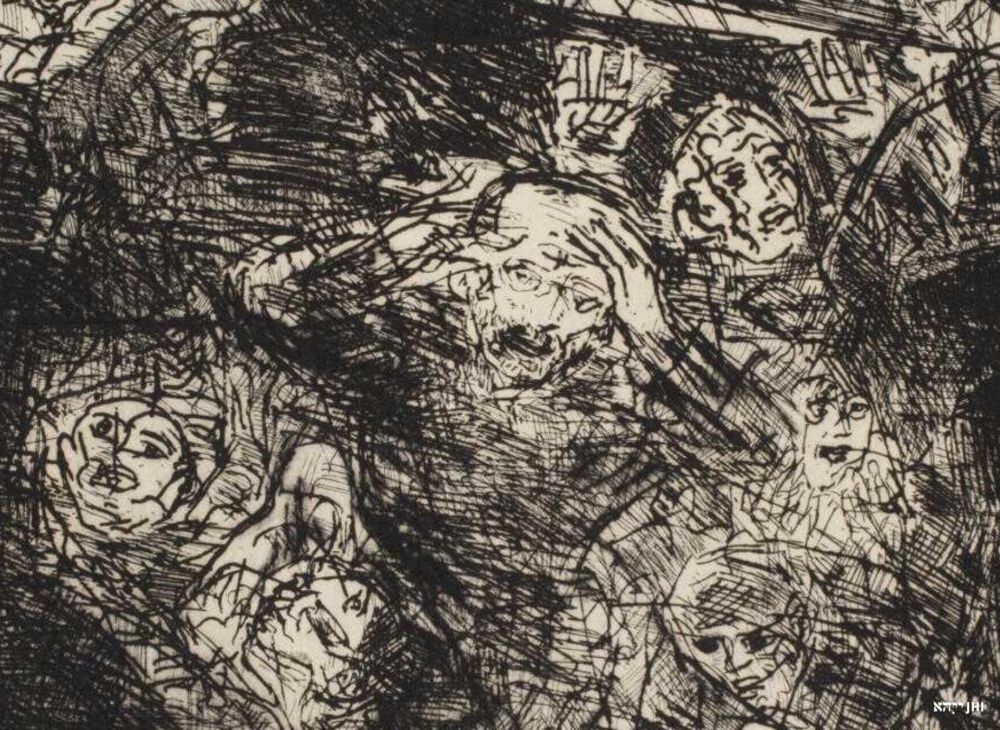- News
- Events
- Oneg Shabbat
- Collections
- Research
- Exhibitions
- Education
- Publishing Department
- Genealogy
- About the Institute
- Bookstore


Izaak Celnikier, "Umschlagplatz (Korczak)", another title: "Death of Janusz Korczak (detail)
We do not know when and where exactly Korczak – educator, writer, social activist who helped countless orphans, children and adults in need in his life, and became an inspiration for millions of other people – was murdered. Perhaps at the Umschlagplatz, the collection point for Jews deported from the Warsaw Ghetto. Maybe he died of lack of air and water in an overcrowded train to Treblinka. It is possible that it was on August 6, 1942 in the Treblinka extermination camp, as transports usually left Warsaw in the evening and arrived there in the morning of the next day. A few years ago, the court adopted the date of Korczak's death on August 7th.
“I suggested to Korczak that he should come with me to the [Jewish] commune in order to persuade it to intervene. He refused, he did not want to leave the children even for a minute," said Nachum Remba, who led many Jewish intellectuals out of the Umschlagplatz. Korczak did not accept the offer of his friends to leave the ghetto, even from the Umschlagplatz itself, a place of suffering and death for thousands of Jews. Rumors that the Germans themselves offered Korczak to spare his life are probably a myth.
![celnikier_korczak_zw_1.jpg [496.13 KB]](https://www.jhi.pl/storage/image/core_files/2022/8/4/eb2c54017b68c984f07195e4c85a9df3/jpg/jhi/preview/celnikier_korczak_zw_1.jpg)
There are dozens of contradictory accounts of people who saw the last path of Korczak, Wilczyńska and the orphans to the Umschlagplatz. They all agree it was an extremely hot day. Some said that the children proudly carried the banners of the Orphanage. But others remembered it quite differently.
Marek Rudnicki recalled:
“There was a terrible, tired silence. Korczak dragged leg by leg, looking shrunken, mumbling something to himself from time to time. When I remember this scene – it rarely leaves me – I thought I heard him mumbling the word ‘why’ – I was close enough to hear it. But this is definitely just a freak of my imagination in retrospect. (...) These few adults from the Orphans' Home, including Stefa, walked alongside, like me or behind him, children initially in fours, then, as it happened, in confusion, one after another. One of the children was holding Korczak by the lapel, maybe by the hand, they were walking as if in a trance”.
After the war, Chaim Sztajer, one of the surviving members of the Sonderkommando in Treblinka, who fought in the revolt of August 2, 1943, claimed to have participated in taking Korczak's body and bodies of "200 to 300 children" out of the gas chamber. However, he stated that it took place in September 1942, and the deaths of Korczak and the children could take place only at the beginning of August.
___
Izaak Celnikier (1923-2011) was a ward of the Korczak Orphanage from 1934 to 1938. During the war he was a prisoner of the Białystok ghetto, Auschwitz, Mauthausen, Sachsenhausen and Flossenbürg. This is how he imagined Korczak's arrival at the Umschlagplatz. The etching from the 1980s belongs to the JHI collection.
Celnikier “created a study of eleven faces emerging from the darkness, with the face of Janusz Korczak in the middle of the work. The woman shown horizontally in the upper left part of the show is most likely dead. The figures of the executioners were marked with darker spots".
![korczak_post_ze_szlenglem_2019.jpg [922.37 KB]](https://www.jhi.pl/storage/image/core_files/2022/8/4/507f1661393f175b43bac3b5986e153b/jpg/jhi/preview/korczak_post_ze_szlenglem_2019.jpg)
___
Source of information: Agnieszka Witkowska-Krych (ŻIH, UW), “Mniej strachu. Ostatnie chwile z Januszem Korczakiem” [Less fear. Last moments with Janusz Korczak], Wydawnictwo Akademickie Dialog Publishing House, Warsaw 2019.